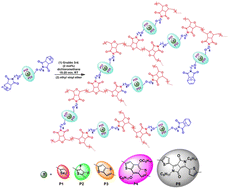Molecular strategy towards ROMP-derived hyperbranched poly(olefin)s featuring various π-bridged perylene diimides†
Abstract
Synthesis of ring-opening metathesis polymerization (ROMP)-derived highly conjugated chromophore functional hyperbranched polymers still remains a challenge. In this work, we introduce a series of cycloolefin monomers based on oxanorbornene imides attached to the bay-region of perylene diimide (PDI)-derived A–D–A-type chromophores as hyperbranched polymers. These molecules, bearing various (π)-bridging units such as selenophene (M1), 3,4-difluorotiophene (M2), thienothiophene (M3), benzodithiophene (M4), and diketopyrrolopyrroles (M5) represent various geometrical and optoelectronic properties. ROMP has been used to synthesize hyperbranched-type poly(oxanorbornene imide)s to encapsulate the perylene diimides into the non-conjugated polymer matrix. The photophysical properties, as well as molecular structural features of all monomers and polymers were investigated using UV-Vis and fluorescence spectroscopic analysis revealing different stages of organization in the solution upon polymerization and film formation. The locked hyperbranched polymeric structural patterns and the film morphology examined by AFM characterization elucidated a homogenous smooth polymer surface irrespective of the size or electronic properties of π-linkers present in the perylene diimides. In addition, cyclic voltammetry (CV) analysis revealed that ruthenium-alkylidene-initiated ROMP-derived hyperbranched polymers can be potential candidates as electron-accepting materials with excellent film-forming ability and thermal stability. On the basis of the experimental investigations and theoretical calculations, herein, we describe the unusual π–π stacking behavior and molecular strategies of both monomers and their corresponding polymers in solution as well as in the solid-state. This approach allows gaining control over the highly π–π stacking behavior of PDI-derived chromophores, with examples of high solubility and quality film formation on demand, which could be ideal for photovoltaic applications.



 Please wait while we load your content...
Please wait while we load your content...